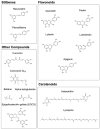Potential Synergistic Supplementation of NAD+ Promoting Compounds as a Strategy for Increasing Healthspan
- PMID: 36678315
- PMCID: PMC9861325
- DOI: 10.3390/nu15020445
Potential Synergistic Supplementation of NAD+ Promoting Compounds as a Strategy for Increasing Healthspan
Abstract
Disrupted biological function, manifesting through the hallmarks of aging, poses one of the largest threats to healthspan and risk of disease development, such as metabolic disorders, cardiovascular ailments, and neurodegeneration. In recent years, numerous geroprotectors, senolytics, and other nutraceuticals have emerged as potential disruptors of aging and may be viable interventions in the immediate state of human longevity science. In this review, we focus on the decrease in nicotinamide adenine dinucleotide (NAD+) with age and the supplementation of NAD+ precursors, such as nicotinamide mononucleotide (NMN) or nicotinamide riboside (NR), in combination with other geroprotective compounds, to restore NAD+ levels present in youth. Furthermore, these geroprotectors may enhance the efficacy of NMN supplementation while concurrently providing their own numerous health benefits. By analyzing the prevention of NAD+ degradation through the inhibition of CD38 or supporting protective downstream agents of SIRT1, we provide a potential framework of the CD38/NAD+/SIRT1 axis through which geroprotectors may enhance the efficacy of NAD+ precursor supplementation and reduce the risk of age-related diseases, thereby potentiating healthspan in humans.
Keywords: NAD+; NMN; SIRT1; age-related diseases; aging; flavonoids; geroprotectors; healthspan; longevity; nutraceuticals; resveratrol; senolytics; supplements.
Conflict of interest statement
A.S. is a master student at ETH Zurich and Research and Development Intern at AVEA Life AG, Switzerland. S.C. is a Co-founder and Chief Product Officer at AVEA Life AG. E.R. is a Chief Scientific/Medical Officer and Partner at Maximon AG, Switzerland. C.Y.E. is a Co-founder and shareholder of Avea Life AG, and is on the Scientific Advisory Board of Maximon AG, Switzerland, Biotein, Canada, Longaevus Technologies Ltd., UK, and Galyan Bio, Inc, USA.
Figures



Similar articles
-
NAD+ Precursors Nicotinamide Mononucleotide (NMN) and Nicotinamide Riboside (NR): Potential Dietary Contribution to Health.Curr Nutr Rep. 2023 Sep;12(3):445-464. doi: 10.1007/s13668-023-00475-y. Epub 2023 Jun 5. Curr Nutr Rep. 2023. PMID: 37273100 Free PMC article. Review.
-
NAD+ Intermediates: The Biology and Therapeutic Potential of NMN and NR.Cell Metab. 2018 Mar 6;27(3):513-528. doi: 10.1016/j.cmet.2017.11.002. Epub 2017 Dec 14. Cell Metab. 2018. PMID: 29249689 Free PMC article. Review.
-
Importance of NAD+ Anabolism in Metabolic, Cardiovascular and Neurodegenerative Disorders.Drugs Aging. 2023 Jan;40(1):33-48. doi: 10.1007/s40266-022-00989-0. Epub 2022 Dec 13. Drugs Aging. 2023. PMID: 36510042 Review.
-
Drugs Targeting Mechanisms of Aging to Delay Age-Related Disease and Promote Healthspan: Proceedings of a National Institute on Aging Workshop.J Gerontol A Biol Sci Med Sci. 2023 Jun 16;78(Suppl 1):53-60. doi: 10.1093/gerona/glad034. J Gerontol A Biol Sci Med Sci. 2023. PMID: 37325957 Free PMC article.
-
Nicotinamide riboside kinases display redundancy in mediating nicotinamide mononucleotide and nicotinamide riboside metabolism in skeletal muscle cells.Mol Metab. 2017 May 29;6(8):819-832. doi: 10.1016/j.molmet.2017.05.011. eCollection 2017 Aug. Mol Metab. 2017. PMID: 28752046 Free PMC article.
Cited by
-
β-Nicotinamide Mononucleotide Promotes Cell Proliferation and Hair Growth by Reducing Oxidative Stress.Molecules. 2024 Feb 8;29(4):798. doi: 10.3390/molecules29040798. Molecules. 2024. PMID: 38398550 Free PMC article.
-
NADH Intraperitoneal Injection Prevents Lung Inflammation in a BALB/C Mice Model of Cigarette Smoke-Induced Chronic Obstructive Pulmonary Disease.Cells. 2024 May 20;13(10):881. doi: 10.3390/cells13100881. Cells. 2024. PMID: 38786103 Free PMC article.
-
Epithelial NAD+ depletion drives mitochondrial dysfunction and contributes to intestinal inflammation.Front Immunol. 2023 Sep 7;14:1231700. doi: 10.3389/fimmu.2023.1231700. eCollection 2023. Front Immunol. 2023. PMID: 37744380 Free PMC article.
-
Vitamin D, Cellular Senescence and Chronic Kidney Diseases: What Is Missing in the Equation?Nutrients. 2023 Mar 10;15(6):1349. doi: 10.3390/nu15061349. Nutrients. 2023. PMID: 36986078 Free PMC article. Review.
-
Enhancing adipose tissue functionality in obesity: senotherapeutics, autophagy and cellular senescence as a target.Biol Res. 2024 Aug 8;57(1):51. doi: 10.1186/s40659-024-00531-z. Biol Res. 2024. PMID: 39118171 Free PMC article. Review.
References
Publication types
MeSH terms
Substances
Grants and funding
LinkOut - more resources
Full Text Sources
Research Materials

